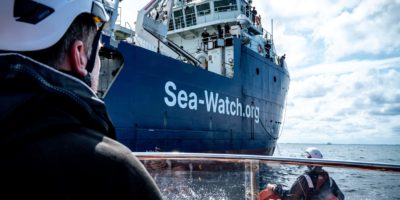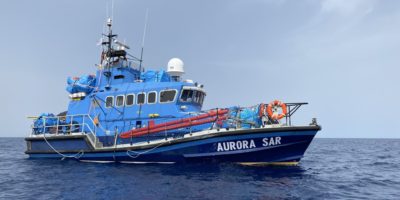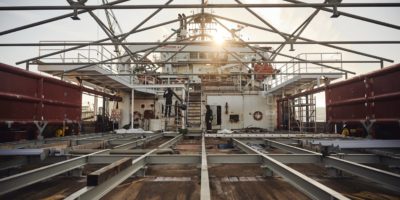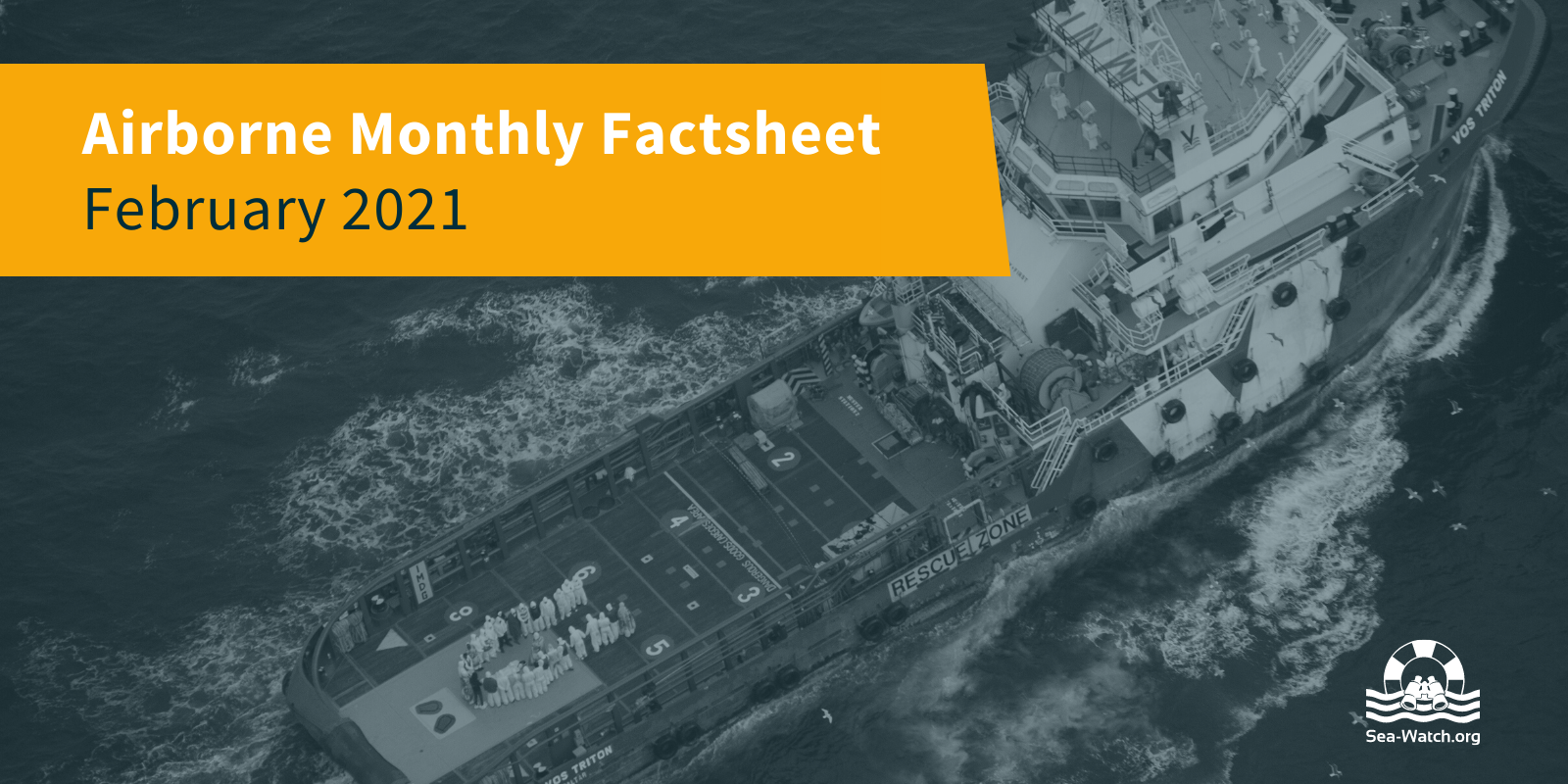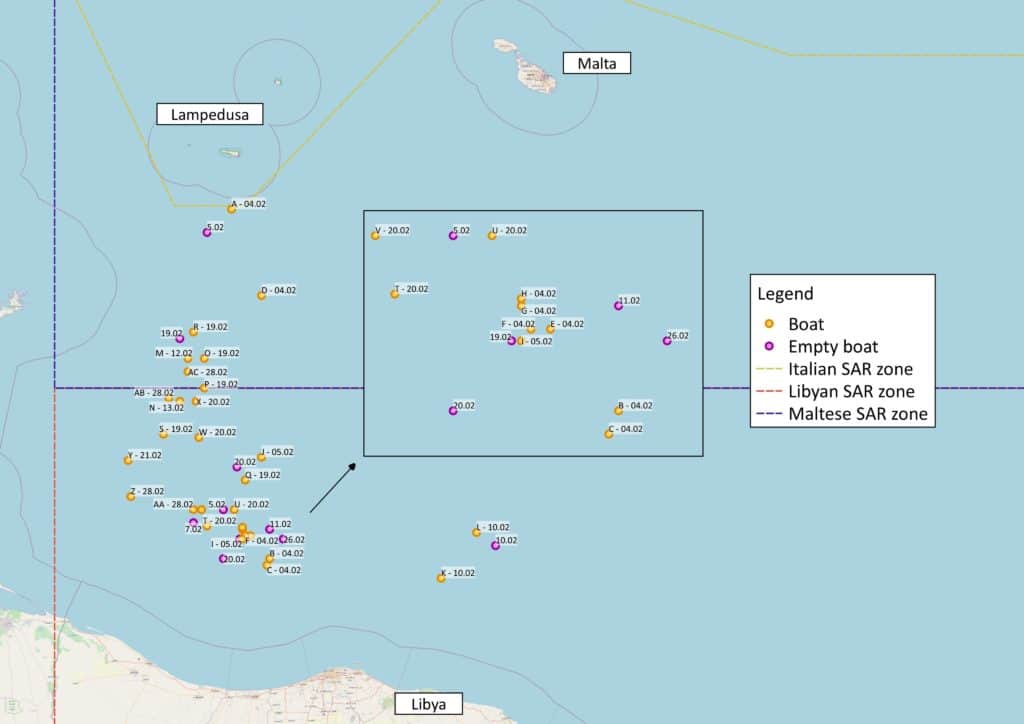This factsheet outlines a summary of the distress cases witnessed in February 2021 by Sea-Watch’s Airborne crew with their aircraft Moonbird and Seabird.* In February 2021 we flew 14 missions, with a total flight time of 78 hours and 37 minutes. We spotted around 2344 persons in distress in 29 different boats.
*Since 2017, together with the Swiss NGO Humanitarian Pilots Initiative, Sea-Watch monitors the Central Mediterranean with its aircraft Moonbird and more recently Seabird.
Overview of Distress Cases and Empty Boats Spotted
Maltese Search-and-Rescue (SAR) zone
2 distress cases, around 124 persons, were rescued by the Italian Coast Guard and disembarked in Lampedusa, Italy
1 distress case, 40 persons, was rescued by the NGO vessel Open Arms and disembarked in Porto Empedocle, Italy
3 distress cases, 368 persons, arrived independently in Lampedusa, Italy
The outcome of 1 distress case, around 50 persons, remains uncertain
Estimated** number of persons in distress: around 582
** These numbers are based upon the estimations of Moonbird and Seabird’s crews, as well as numbers which the initiative Watch The Med – Alarm Phone, Mediterranean Hope-FCEI, the UNHCR and the IOM have provided to us.
Libyan Search-and-Rescue (SAR) zone
11 distress cases, around 954 persons, were likely intercepted by the so-called Libyan Coast Guard and pulled back to Libya
4 distress cases, around 265 persons, were likely rescued by the Italian Coast Guard and disembarked in Lampedusa, Italy
1 distress case, 67 persons, arrived independently in Lampedusa, Italy
1 distress case, 106 persons, was rescued by the NGO vessel Open Arms and disembarked in Porto Empedocle, Italy
1 distress case, 45 persons, was rescued by the NGO vessel Sea-Watch 3 and disembarked in Augusta, Italy
The outcome of 4 distress cases, around 325 persons, remains uncertain
Estimated number of persons in distress: around 1762
Details and outcomes of selected distress cases
On 04.02. alone, Moonbird’s crew spotted 8 boats in distress, carrying around 510 persons.
04.02., distress case B and C, respectively around 100 persons and around 79 persons: interceptions and pullbacks to Libya by the so-called Libyan Coast Guard. The people in distress in both cases were spotted in close proximity to one another in the Libyan SAR zone. The so-called Libyan Coast Guard patrol boat P300 was in the vicinity of the people aboard distress case C. Based upon comparisons of our photographs with those published by the UNHCR, we are certain that in both cases the people in distress were intercepted by the so-called Libyan Coast Guard and pulled back to Libya.
04.02., an unknown asset relayed information about a boat in distress. On 04.02., an unidentified asset called the NGO vessel Ocean Viking 6 times as well as aircraft Moonbird via radio, asking whether the aircrew could contact the Ocean Viking. The unknown asset then relayed the coordinates of a boat in distress to Moonbird’s crew and thanked them using the German “dankeschön”. Moonbird’s crew sent the information to the authorities as well as the NGO vessel Ocean Viking, since she was the only asset in the vicinity of the given position. The Ocean Viking found 116 persons in distress and rescued them immediately. The people were disembarked on 08.02. in Augusta, Italy.
04.02., distress case G and H, respectively 45 and around 100 persons: 2 boats sailing together, 1 rescued and 1 pulled back to Libya. On 04.02., Moonbird’s crew spotted the people aboard both boats in the Libyan SAR zone apparently sailing together. The people aboard case G were later found adrift by the NGO vessel Astral in the Maltese SAR zone, which provided them with assistance and distributed life vests. The people were eventually rescued by an Italian Coast Guard patrol boat and disembarked in Lampedusa, Italy. In distress case H, the people were intercepted by the so-called Libyan Coast Guard and pulled back to Libya.
07.02., a burning empty boat and interception likely coordinated by Frontex aircraft. On 07.02., Moonbird’s ground crew observed Frontex aircraft Eagle1 orbiting a position in the Libyan SAR zone. When Moonbird’s aircrew arrived on scene, an empty boat was burning on the water and a so-called Libyan Coast Guard vessel was spotted with around 32 persons on deck, who were later pulled back to Libya. According to the observed Frontex track, we have to assume that Frontex aircraft once again coordinated a pullback to Libya of people on the move.
10.02., distress cases K and L, around 100 and 110 persons: delegation of the duty to render assistance to the so-called Libyan Coast Guard, pullback to Libya, coordinated by a surveillance aircraft. On 06.02., Seabird’s crew first spotted one boat with around 100 persons in distress in the Libyan SAR zone (distress case K). The crew later overheard via radio an unknown aircraft calling the so-called Libyan Coast Guard and providing them with the position of a “target”. Seabird flew to the given position and found around 110 persons in distress (distress case L). The same unidentified aircraft also eventually provided the so-called Libyan Coast Guard with the coordinates of “number 2 target”, which was distress case K. For the entire mission, the aircraft kept providing the coordinates of “number 1 target” and “number 2 target” to the so-called Libyan Coast Guard. Observed by Seabird, the so-called Libyan Coast Guard patrol boat Ubari eventually intercepted the people aboard both cases and pulled them back to Libya. Both boats were later matched with reported cases from the initiative Watch The Med – Alarm Phone.
Based upon aircraft track observations, only an aircraft belonging to the Armed Forces of Malta (AFM) was operating in the same area as Seabird on this day. We hence believe that this Maltese aircraft coordinated the interceptions.
12.02., distress case M, 40 persons: Frontex and Maltese aircraft involvement, non-assistance of Merchant vessels regarding a distress case, so-called Libyan Coast Guard intimidation of NGO crew in the Maltese SAR zone. Seabird’s ground crew observed in the morning that Frontex aircraft Eagle1 was orbiting a position in the Maltese SAR zone. When arriving on-scene, Seabird’s crew found 40 persons in distress who were not wearing any life vests. The waves at this time were higher than 1 meter. The merchant vessel Vos Triton, flying the flag of Gibraltar, was the nearest vessel. The port authorities of Lampedusa were informed via radio about the people in distress and confirmed that they would coordinate with the Italian Coast Guard regarding the case. Meanwhile, the Vos Triton was heading away from the people, and the merchant vessel Asalet, flying the Turkish flag, altered its course to assist the people. The Maltese authorities only took the information provided by Seabird’s ground crew but provided no information in return, insisting that they were busy with many cases. The Italian authorities confirmed having received the email from the ground crew but also did not provide any further information and advised a call to the “competent authorities”, namely the Maltese. Proceeding with the mission, Seabird’s crew found the so-called Libyan Coast Guard patrol boat Fezzan in the Maltese SAR zone, heading at full speed towards the people in distress. The Libyan authorities were never informed by Seabird’s ground crew concerning this boat in distress, since the boat was located in the Maltese SAR zone. Therefore we have to assume that the presence of the so-called Libyan Coast Guard in the Maltese SAR zone must have been coordinated by one of the European actors involved in the case. The NGO vessel Open Arms then also arrived on-scene and headed towards the people. Seabird’s crew observed the so-called Libyan Coast Guard next to an Open Arms RHIB***, trying to block the RHIB by driving in front of it and using the ensuing waves to disrupt its course. The so-called Libyan Coast Guard patrol boat then headed south, passed by another deployed RHIB. When Seabird’s crew checked for a final time on the people in distress, an aircraft belonging to the Armed Forces of Malta was also on-scene. The people were rescued in the evening by the NGO vessel Open Arms and disembarked in Porto Empedocle, Italy on 16.02.
13.02., distress case N, 106 persons: refusal of a merchant vessel to render assistance. The 106 people in distress had called the initiative Watch The Med – Alarm Phone, which immediately alerted the authorities. The civilian aircraft Colibri 2 was on-scene in the morning. When Moonbird’s crew spotted the people in the afternoon, the merchant vessel Alpine Aqualina, flying the Liberian flag, was in the vicinity. When Moonbird’s crew reached out to the vessel via radio, its crew refused to render assistance, arguing with the coronavirus pandemic and the fact that the people “were not in distress, since nobody was in the water”. This rubber boat was overloaded and the people were not wearing life vests – within any minute it could have sunk. Around half an hour later, the vessel agreed to monitor the people in distress. The Maltese RCC was called by Moonbird’s ground crew but refused to share any information. Later, the people were spotted in the Maltese SAR zone with the Frontex aircraft Osprey on-scene. The people were eventually rescued by the NGO vessel Open Arms and disembarked in Porto Empedocle, Italy, on 16.02.
On 19.02., Moonbird spotted 5 boats in distress, carrying around 463 persons.
19.02., distress case R, 217 persons: dangerous journey at sea, no rescue asset deployed. Moonbird’s crew found 217 persons without any life vests in a wooden boat in the Maltese SAR zone. The authorities were informed but did not deploy any rescue assets. Despite the high risk for loss of life, the people arrived independently in Lampedusa, Italy.
On 20.02., Airborne spotted 5 boats in distress, carrying around 387 persons. Airborne also spotted 1 merchant vessel with 77 persons onboard.
20.02., distress cases T, U, V, respectively around 70, 80 and 70 persons: delegation of the duty to render assistance to the so-called Libyan Coast Guard, interceptions and pull backs to Libya. Moonbird spotted 3 boats in the Libyan SAR zone. None of the people aboard these boats were wearing life vests, and the boats were overloaded. Moonbird observed the interception of people by the so-called Libyan Coast Guard for distress case T. When the civilian aircraft Colibri 2 arrived on scene, the people aboard distress case U had also just been intercepted. The third boat was also likely intercepted that evening by the so-called Libyan Coast Guard. Around 220 persons were pulled back to Libya.
20.-21.02., distress case W, 77 persons: delay in rendering assistance, with assumed risk of loss of human lives. Moonbird’s crew spotted the persons on 3 occasions: during the late morning of 20.02. in the Libyan SAR zone, then in the Maltese SAR zone during the afternoon and finally again on the morning of 21.02. Authorities were informed accordingly. The merchant vessel Vos Triton, flying the flag of Gibraltar, looked for the people but could not find them. Almost 30 hours after the first sighting, the people were rescued on the evening of the 21.02 by the Italian Coast Guard and disembarked in Lampedusa.
20.02., shipwreck, at least 41 missing persons, a merchant vessel rescuing persons left alone by the authorities. On 20.02., around 120 persons in distress in the Libyan SAR zone called the initiative Watch The Med – Alarm Phone, which immediately informed the authorities. Moonbird’s crew then spotted the Vos Triton, flying the Gibraltar flag, with 77 persons and 1 dead body onboard. The Vos Triton confirmed having conducted a rescue operation in the position of the boat with around 120 persons. The Vos Triton was then waiting for guidance from the authorities, which did not provide any. Moonbird’s crew was hence asked to forward a message to the Maltese Rescue Coordination Centre (RCC). Due to a lack of support and in compliance with the law, the vessel sailed to Lampedusa on its own. Moonbird’s crew spotted the vessel again on 21.02., where the rescuees on the deck were gathered in a circle around the deceased person, likely having a small ceremony. After the vessel waited for a time off the coast of Lampedusa, it was finally assigned a port in Porto Empedocle, Sicily, where the people were disembarked on 22.02.
According to testimonies provided to the IOM, the UNHCR and AP, the boat was carrying around 120 persons when it departed from Libya. At some point it began to take in water, and 6 persons fell into the water while 2 drowned swimming towards a vessel in the vicinity. The survivors reported that several other persons died during Vos Triton’s rescue operation, in which the merchant vessel was able to take 77 persons and only 1 dead body on board. Therefore we have to assume that at least 40 persons lost their lives.
20.02., distress case X, around 90 persons: mayday relay**** by Frontex in the Libyan SAR zone. Moonbird’s crew overheard information relayed via radio about a boat in distress and headed to the scene. When Moonbird spotted the people, the merchant vessel Vos Triton, which already had 77 persons on board, was the closest vessel. She confirmed that she would head to the people, but did not. During the evening, based on its track, another merchant vessel, the Stornes, flying the flag of Netherlands, stood by and left the scene. The outcome of this distress case is unknown.
21.02., distress case Y, around 70 persons: critical situation, the Italian MRCC acting on behalf of the Libyan authorities, delegation of the duty to render assistance to the so-called Libyan Coast Guard. Moonbird’s crew spotted around 70 persons aboard a boat without an engine adrift in the Libyan SAR zone. Moonbird’s crew sent out a mayday relay4 via radio which remained unresponded to. The authorities were informed via emails and/or calls of the severe risk to life carried by this boat. Almost 3 hours later, the oil platform Bouri confirmed having received the pertinent information and attempted to call vessels in the vicinity on the radio. Meanwhile, the Italian Maritime Rescue Coordination Centre (MRCC) sent an “inmarsat C” message***** to all vessels transiting in the Southern Mediterranean, acting “on behalf of the (so-called) Libyan Navy Coast Guard” providing all information on the boat in distress and requiring any vessels to “please accordingly to your course and speed, keep a sharp lookout and report any sighting to JRCC (Joint Rescue Coordination Centre) Libya”. The message further listed contacts of JRCC Libya. The civilian aircraft Colibri 2 later documented the dramatic interception of the people by the so-called Libyan Coast Guard – the tubes of the rubber boat were deflated, according to the NGO, and around 20 persons were in the water.****** The people were pulled back to Libya.
26.02, empty boat in the Libyan SAR zone, likely the result of an interception coordinated by Frontex aircraft despite an NGO vessel being in the vicinity. Moonbird’s crew spotted an empty rubber boat in the Libyan SAR zone. Its position coincides with reports from the crew of the NGO vessel Sea-Watch 3, having observed the so-called Libyan Coast Guard patrol boat Fezzan with intercepted persons on board, and with orbits of Frontex aircraft Osprey1 on the same morning, as witnessed by Moonbird’s ground crew.
On 28.02., Moonbird spotted 4 cases, with 291 persons onboard.
28.02., distress case AA, 45 people: ongoing rescue operation of an NGO vessel, lack of rescue assets in the Central Mediterranean, joint efforts by civil society. On 28.02., Moonbird documented from the air the rescue operation of 98 persons conducted by the NGO vessel Sea-Watch 3. Later, Moonbird’s crew spotted the 45 people in the Libyan SAR zone. The NGO vessel Sea-Watch 3, as the only rescue asset, headed to the people and conducted a rescue operation. The 45 persons were rescued by the NGO vessel Sea-Watch 3. The persons were disembarked during the 03.-05.03 in Augusta, Italy.
28.02., distress case AB, 83 persons: delay by authorities in rendering assistance. Moonbird’s crew spotted the people in the Libyan SAR zone and alerted the authorities. The merchant vessels Drawsko, flying the Bahamian flag, and Maridive Zohr II, flying the flag of Panama, were in the vicinity of the distress cases Z, AB and AC but did not render assistance, despite authorities and respective shipping companies being alerted. Meanwhile, it appeared that the people in distress had called the initiative Watch The Med – Alarm Phone, which also alerted the authorities. The people were eventually found by the NGO vessel Sea-Watch 3, already carrying 363 rescuees from 5 previous operations. The NGO vessel launched her RHIBs and stabilized the situation before waiting around 5 hours for the Italian authorities to launch a rescue operation and rescue the people. The people were finally taken on board an Italian Coast Guard vessel and disembarked in Lampedusa, Italy.
In February, Airborne’s crews spotted 11 empty boats: 1 was the remains of an NGO rescue operation, 1 was likely the remains of a rescue operation by the Italian Coast Guard and 2 were likely interceptions by the so-called Libyan Coast Guard. The outcomes for 7 empty boats remain unknown.
*** A rigid inflatable boat is a fast, lightweight, and stable boat usually used by the military for operations at sea.
**** A “mayday relay” is an emergency procedure which provides information about a boat in distress via maritime or aerial radio, requesting any asset in the vicinity to assist.
***** “Inmarsat” stands for International Maritime Satellite and is a satellite telecommunication system transmitting messages from ship-to-shore, shore-to-ship and ship-to-ship. This system is particularly used by Rescue Coordination Centres and vessels in distress.
****** A video of the interception is available at: https://twitter.com/PVolontaires/status/1363858440146272257?s=20.
These missions highlight once again:
- the deadly consequences of European migration and border policies
- the systematic non-assistance by European Member States and their delegation of rescue operations to the so-called Libyan Coast Guard, even in European SAR zones
- the participation of the European Border and Coast Guard Agency Frontex in the interceptions and pullbacks undertaken by the so-called Libyan Coast Guard
- the involvement of merchant vessels in rescue operations due to the lack of a European sea rescue program
- the unjustified and systematic delays by European Member States in fulfilling their obligations to conduct and coordinate sea rescue operations
- the need for NGO vessels in the Central Mediterranean Sea in order to uphold the law and save human lives

